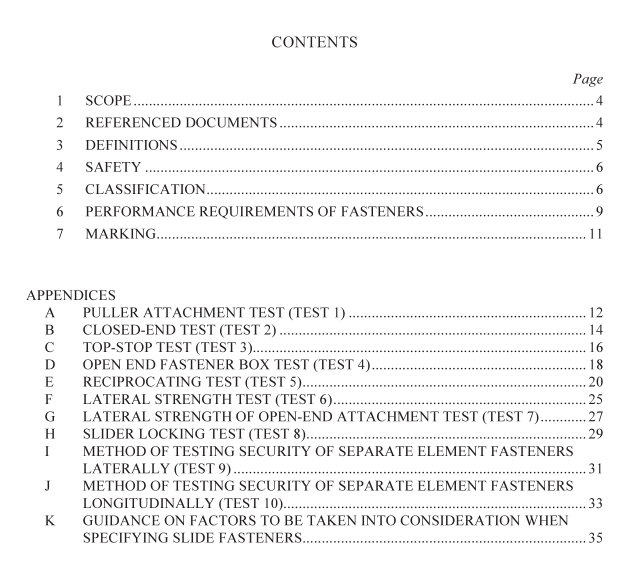AS 2332 pdf download – Slide fasteners

AS 2332 pdf download – Slide fasteners
3DEFINITIONS
For the purpose of this Standard the following definitions apply. Diagrams of the basiccomponents, dimensions and types of slide fastener which illustrate many of the definitionsin this Clause are given in Figures 1 to 4.
3.1Slide fastener
A fastening device consisting of two flexible, interlocking stringers (see Clause 3.3.9), withor without end stops,and a slider (see Clause 3.3.8) so arranged that by moving the slideralong the stringers in one direction an opening is formed, and by moving it in the other theopening is closed. The end that is adjacent to the slider when the device is fully open isdesignated the bottom end. The other end is designated the top end.
3.2 Batch of fasteners
A quantity of fasteners having one design, one performance code and one size or box (seeClause 3.4.3).
3.3Fastener components and dimensions3.3.1 Botiom stop
The stop at the bottom end of the chain that checks the opening movement of the slider (seeFigure 2(a)).
3.3.2 Chain
A continuous closure formed by interlocking two compatible stringers (see Figure 1).3.3.3 Chain width
The width across the interlocked elements on which the slider runs (see Figure 2(b)).3.3.4 Elements
Metal or plastic teeth fixed to the edge of tapes which engage or separate from each otherunder the action of the slider.
3.3.5 Length of fastener
The distance from the top of the slider to the bottom of the bottom stop, or box in the caseof an open-end fastener,measured with the slider in the top position and with the puller inthe downward position (see Figure 2(b)).
3.3.6Locking device
A device incorporated in the slider unit restricting its free movement along the fastenerlength in an opening direction.The locking device may operate either automatically onrelease of the puller or by manual pressure on the puller.
3.3.7 Puller (or pull)
The fitting attached to the slider to facilitate manipulation.3.3.8Slider
The moving component consisting essentially of a slider body and, normally, a puller whichopens or closes the fastener by separating or engaging the interlocking members. The slidermay incorporate a locking device.
3.3.9 Stringer
A textile tape with an attached row of elements designed to interlock with a row similarlyattached to another tape.
3.3.10 Tape
Narrow fabric to which elements are fitted.3.3.11 Top stop
The stop(s) at the top end of the chain that check(s) the closing movement of the slider.3.4 Types of fastener
3.4.1 Closed-end fastener
A slide fastener which does not permit the complete separation of the two stringers.Normally the open end of the fastener separates as the slider is lowered, although there is anadditional type where the top ends are permanently joined together by means of a bridgestop (see Figures 3(a) and 3(b)).
3.4.2 Concealed fastener
A slide fastener with the tapes folded so that on closure neither the slider body nor thefastener are visible from the outside of the article.
3.4.3Open-end fastener
A slide fastener having a special fitment at the bottom end of each stringer in place of thebottom stop,so designed as to permit the two stringers to be completely separated andreassembled at will when the slider is in the fully open position. The special fitmentnormally consists of a pin permanently fixed to the bottom end of one stringer which fitsinto a box permanently fixed to the bottom end of the other stringer. At both ends ofseparated chain there is a stopper that prevents the slider from being removed (refer toFigure 3(c)).
3.4.4Two-way fastener
A slide fastener fitted with two sliders that operate with equal facility in either direction.This type is available in a variety of forms which are illustrated in Figure 4.
4 SAFETY
lt shall not be possible for the slider to come off the fastener in normal use.5 CLASSIFICATION
Slide fasteners are classified according to chain width (the width of gear elements) and bytheir end-use.
Slide fasteners of either the closed-end type or the open-end separable type shall beclassified in accordance with the requirements of Table 1.
Table 2 specifies the minimum performance requirements for each classification.









